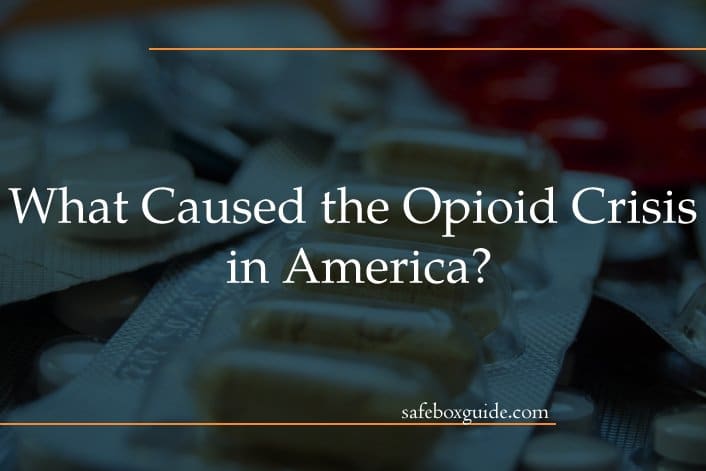It’s likely that when you go to your doctor and they write you a prescription, you don’t question the safety of the medications prescribed. Presumably, your physician is someone you trust. You probably never consider that this prescription could potentially risk your life and the lives of your family members. However, in the mid-1990s, this was not the case for millions of Americans.
The opioid crisis in America is still very much alive. It is an epidemic traced back to poor regulation and ill-advised physicians. The effects are still affecting families and communities across the country today. Throughout the US, there are dedicated treatment options to help those suffering from opioid addiction. Recovery is not an easy journey, but with the right support, it is possible.
Contents
What Are Opioids?

Opioids are a class of psychoactive drugs. A psychoactive drug affects brain chemistry, meaning these drugs can influence and change a person’s behavior, emotions, thoughts, and moods. Commonly distributed prescription opioids include morphine, oxycodone, and codeine. These drugs are prescribed for severe pain relief.
An infamous opioid, known as fentanyl, is sometimes legally prescribed as a lozenge or skin patch for pain relief. However, it is frequently abused in the United States when it is illegally and synthetically manufactured. Fentanyl is a highly potent opioid. For this reason, it is responsible for most opioid overdoses today.
Heroin, another infamous opioid, is made from morphine. It is an illegal drug known to be highly addictive. Ingesting heroin produces euphoric effects, but a person will require higher doses to obtain this effect over time. With repeated abuse of heroin, a person can develop physical and mental dependence on the drug. Drug dependence makes it very difficult to quit cold turkey as the person addicted will experience painful withdrawal symptoms. Heroin is destructive as those who take it are at high risk of overdose. This synthetic opioid can be taken by snorting, smoking, or injecting.
The History of Opioids
Opioids are made from opium, which naturally occurs in the poppy plant. The poppy plant is native to South and East Asia, Europe, and North Africa. Growing poppy plants is forbidden in the US without a license under the Opium Poppy Control Act of 1942. However, despite attempts to eradicate its growth, it can now be found worldwide.
While opium has been used as a painkiller for centuries, the opioid crisis could be described as beginning in 1805. That year, a German physician named Friedrich Wilhelm Adam Sertürner first separated an alkaline substance from opium. He would later name this substance morphine. Before morphine, opium was used and distributed in the US, typically for soldiers fighting in the Civil War. Since the invention of morphine, prescription opioids have become widely available in pharmacies. In the late 1880s, prescription opioids were unregulated and prescribed for a host of issues, ranging from mental to physical.
Women and Opioids
By the late 1880s, male doctors prescribed opioids for female issues. When women complained to their doctors about menstrual cramps or ovarian complications, they were prescribed opioids. So, before the 1990s, opioid addiction mainly affected middle-class white women. However, in the 1990s, this all changed.
How Did the Opioid Crisis Begin?
In the mid-1990s, the Food and Drug Administration (FDA) approved OxyContin’s highly addictive opioid painkiller. After this, the US began to see a huge number of opioid deaths from legal prescriptions. With a massive number of the American population now addicted to opioids, the sale and distribution of heroin skyrocketed. This subsequently created a rise in heroin-related overdose deaths. With opioid addiction rampant in the fabric of American society, we now see a huge rise in synthetically produced opioid – fentanyl.
Fentanyl has been responsible for many overdose deaths in the US in recent years. This is due to both intentional consumption of fentanyl as well as accidental. Fentanyl is a highly potent opioid that is often mixed and sold illegally. Fentanyl has been found in illegally distributed bars of counterfeit Xanax and powder cocaine.
Addiction is a condition that destroys lives, families, and communities. Millions of preventable deaths from opioids occur in the US each year. Within a society, it creates massive social problems such as unemployment and an increased homeless population. This crisis has also burdened the health system and emergency services.
How Could This Crisis Have Been Prevented?

We must learn from the mistakes of history. This crisis could have been easily avoided with stricter regulation. In the civil suit against Perdue Pharma for their role in OxyContin distribution, released depositions show they purposefully hid the drug’s potency.
Furthermore, the opioid crisis shows how financial greed impacts society. Policymakers have accepted, and continue to accept, donations from large pharmaceutical companies. This allows those companies to continue distributing these destructive substances.
Addiction treatment is an ever-growing industry. However, it still has its limitations. Seeking addiction treatment is stigmatized, expensive, and not accessible to everyone. What treatment is accessible is often of a low quality.
We must warn our children from a young age about the dangers of addiction. Whether during their education or in their families, the young and impressionable in society are most at risk.
The Future of Addiction
There is some hope that the opioid epidemic will one day slow its destruction on American society. Still, as of now, there are over twenty-five million people in recovery from addiction today. Some advances have been made, such as the Affordable Care Act. This act was passed to ensure private healthcare companies cover addiction recovery treatment.
Furthermore, with additional conversation and inclusive language surrounding addiction, treatment has become more widely understood and accessible.
Instead of calling addictive behavior substance use, it has been given a diagnostic term: substance use disorder (SUD). Labeling addictive behavior for what it is, a disorder, allows people to seek help with less stigma. It is easier now than ever to ask for help for opioid addiction or addiction to another substance. There are addiction treatment centers throughout the US and regular research programs investigating new cures. Hopefully, one day, the opioid crisis in America will be a distant memory.

